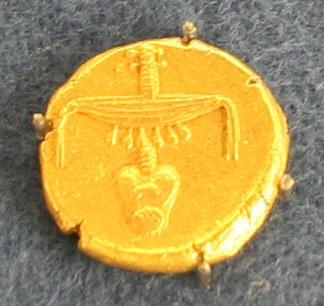
Table of Contents
The Egyptian stater
The gold stater
Issued during the 30th dynasty
The head
Has two hieroglyps
Nfr and nby
Fine gold
Perfect Gold
Beautiful Gold
The tail
Shows a horse
On its hind legs
A unique piece
Rather uncommon
What is a stater in ancient Egypt?
In ancient Egypt, a stater typically refers to a standardized unit of currency that was used in the form of coins or weight-based transactions. However, it’s worth noting that the term stater is more commonly associated with ancient Greek currency, particularly the silver stater, which was also adopted by other cultures around the Mediterranean, including some Egyptian contexts, especially during the Hellenistic period.
Uses of Stater in Ancient Egypt:
Trade: Staters were used in trade and commerce, allowing merchants to exchange goods more easily compared to bartering.
Taxation: They could be used to pay taxes or tributes to the state.
Representation of Wealth: Coins, including staters, were often a representation of wealth and economic power.
Silver stater Value in Today’s Terms:
The exact value of a stater can be challenging to determine today due to differences in economies, currency value fluctuations, and historical context. However, in a very general sense:
- A silver stater could weigh around 10-14 grams of silver.
- The value of silver fluctuates based on market conditions; as of 2024, the price of silver is roughly $ 32,37 € per ounce , which means a stater could be valued in the range of $10-$15, depending on its weight and purity.
It’s important to note that this is a rough estimation, and the historical context and significance of the stater in ancient economies are far more complex than simple monetary equivalence.
Golden stater Value in Today’s Terms:
The weight and value of a golden Egyptian stater can vary based on several factors, including its condition, historical significance, and current gold prices.
Weight:
- A golden stater from ancient Egypt typically weighed around 8.5 grams, but this can vary based on the specific type and period.
Value:
- The value is determined by the current market price of gold and the collectible value of the coin itself.
- As of now, the price of gold is approximately $60-$70 per gram (this fluctuates regularly). Therefore, the intrinsic value of the gold in a stater would be around $510 to $595 based on weight alone.
- Collectible value can significantly increase this price, depending on rarity and demand among collectors.
For a precise current value, it’s best to consult a coin dealer or appraiser who specializes in ancient coins.
The hieroglyphs Nfr and nby
In ancient Egyptian culture, hieroglyphs were a crucial part of their writing system, used primarily for religious texts, monumental inscriptions, and administrative records.
Nfr (nfr): This hieroglyph typically translates to good, perfect, or beautiful. It’s often associated with ideals of harmony, balance, and completeness. The concept of nfr was significant in Egyptian culture, as it was tied to the notion of order (maat) and the well-being of both the individual and society.
Nby (nb): This hieroglyph translates to lord or master. It’s used as a signifier of authority or divine rule. In many contexts, it can refer to deities, pharaohs, or anyone in a position of power and governance.
Both terms played important roles in religious texts, royal titles, and everyday language, conveying significant cultural values and hierarchies within ancient Egyptian society.
The hieroglyphs Nfr and nby on a coin
In an ancient Egyptian context, the hieroglyphs Nfr (nfr) and Nby (nb) used on a coin, could convey significant meanings and messages:
Nfr (nfr): If inscribed on a coin, it could emphasize the quality or value of the coin itself, suggesting that it is good, perfect, or beautiful. This might imply that the coin was worthy of trade or valuable in a more symbolic sense, representing prosperity and well-being.
Nby (nb): When used on a coin, this could imply authority, ownership, or divine sanction. It might indicate that the coin is issued by a ruler or a deity, asserting legitimacy and backing its value. In this context, it may also suggest that the coin carries the blessings of the gods or the state, reinforcing its worth in economic transactions.
Together, these hieroglyphs on a coin could serve as a powerful statement of quality, value, and authority, enhancing its significance in trade and its acceptance in society.
Good to know
Shop tip
Are there collectors among us? Let us know in comments!
Take time to learn
Invest in your future
Embark on a journey into the realm of affiliate marketing and craft your own website within a vibrant, supportive community. Join me in this adventure, where you can begin as a free starter and stay as long as you desire. Enjoy complimentary hosting and foundational teachings to set you on your path. For those with advanced skills, opportunities to elevate your expertise await. Take a moment to explore and witness the magic for yourself!




